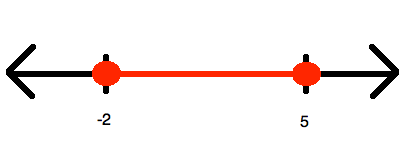Number Line
Help Questions
ACT Math › Number Line
On a number line, what is the distance between –6 and 7?
1
13
–1
–13
3
Explanation
To find distance between two points, take the second and subtract the first.
So 7–(–6) = 7 + 6 = 13
On a number line, what is the distance between –6 and 7?
1
13
–1
–13
3
Explanation
To find distance between two points, take the second and subtract the first.
So 7–(–6) = 7 + 6 = 13
On a number line, what is the distance between –6 and 7?
1
13
–1
–13
3
Explanation
To find distance between two points, take the second and subtract the first.
So 7–(–6) = 7 + 6 = 13
On a real number line, what is the midpoint of –4 and 18?
4
7
8
11
14
Explanation
The integer halfway between –4 and 18 is 7. The number 7 is 11 greater than –4 and 11 less than 18. Another way to determine this would be to find the average of the two numbers: (–4 + 18)/2 = 14/2 = 7.
On a real number line, what is the midpoint of –4 and 18?
4
7
8
11
14
Explanation
The integer halfway between –4 and 18 is 7. The number 7 is 11 greater than –4 and 11 less than 18. Another way to determine this would be to find the average of the two numbers: (–4 + 18)/2 = 14/2 = 7.
What is the distance on a number line between 

Explanation
The distance between 2 numbers on a number line is the sum of their absolute values.
What is the distance on a number line between 

Explanation
The distance between 2 numbers on a number line is the sum of their absolute values.
On a real number line, what is the midpoint of –4 and 18?
4
7
8
11
14
Explanation
The integer halfway between –4 and 18 is 7. The number 7 is 11 greater than –4 and 11 less than 18. Another way to determine this would be to find the average of the two numbers: (–4 + 18)/2 = 14/2 = 7.
What is the distance on a number line between 

Explanation
The distance between 2 numbers on a number line is the sum of their absolute values.

Which of the following inequalities is represented by the number line shown above?
Explanation
Since the inequality represents one range of values between two end points (both of which are included, given the sign being "less than or equal"), you know that whatever you answer, it must be convertible to the form:
Now, you know that it is impossible to get this out of the choices that have no absolute values involved in them. Therefore, the only options that make sense are the two having absolute values; however, here you should choose only the ones that have a 
The wrong answer is simplified in this manner:
And you can stop right here, for you know you will never have 
The other option is simplified in this manner:
This is just what you need!





![[-5] + [12] = 5 + 12 = 17](https://vt-vtwa-assets.varsitytutors.com/vt-vtwa/uploads/formula_image/image/84655/gif.latex)












